Mini Cooper 2008 News
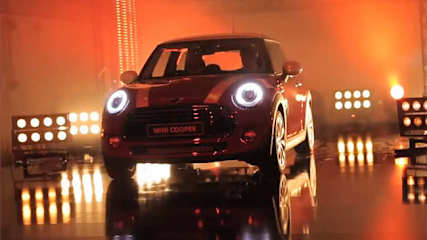
New Mini unveiled | video
Read the article
By Staff Writers · 22 Nov 2013
The new Mini arrives here early next year with new efficient engines, a larger body and some changes to styling, but largely continuing with the signature design recipe.
It has however grown 98mm in length to 3821mm, 44m in width to 1727mm and 7mm in height to 1414mm on a 34mm longer wheelbase at 2495mm to give more cabin room and an additional 51 litres of luggage space.
There's big news under the skin too, where the Mini debuts the new UKL platform that will in time underpin more new Minis and some new models from parent company BMW.
Watch the 2014 Mini Cooper unveiling video on our desktop site.
_______________________________________
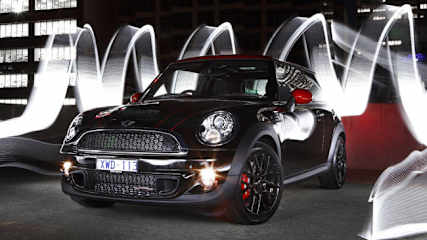
Mini John Cooper Works get new engine
Read the article
By Karla Pincott · 21 May 2012
The new unit is based on the one in the 1.6-litre Mini Cooper S, with twin-scroll turbocharger, direct fuel-injection and variable valve control. The turbocharger is tweaked for extra boost and the engine has been fitted with a new high-performance exhaust system – finished with twin stainless-steel tailpipes.
Engine outputs are 155kW of power at 6000rpm, and 260Nm of torque from 1850-5500rpm, with 280Nm available for a few seconds on overboost between 2000-5200rpm.
It will be mated to a six-speed manual transmission as standard, but there will still be the option of a six-speed automatic with a manumatic mode and shift paddles mounted on the steering wheel.
Mini says the new engine gets a weight-saving aluminium block and bearing mounts, lighter crankshaft, reinforced pistons and a high-strength cylinder head.
The manual transmission gets a fuel saving stop-start system, and the load on the electrical system is reduced by brake energy recapture with the alternator disengaging at high revs – combining to cut your fuel burn by about 500ml per 100km.
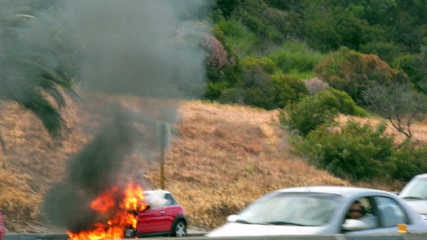
235,000 Mini Cooper S recalled
Read the article
By Stuart Martin · 17 Jan 2012
High performance versions of the Mini Cooper are being recalled worldwide to fix an engine problem that could potentially start a fire.More than 235,000 of the turbocharged Cooper S models built between 2006 and last year are being recalled worldwide to remedy a secondary water pump fitted to cool down the turbocharger.The company has global reports of just over 80 water pump failures and four fires as a result, but BMW Australia and local authorities have deemed the program here to be a technical service campaign,Mini Australia spokesman Piers Scott says just over 3700 Cooper S (of which one may have experienced the smoldering engine bay issue) and John Cooper Works vehicles built between 2006 and 2011 are effected in Australia."This was deemed to be a technical campaign, in-line with similar campaigns conducted in the past," he said.Mr Scott said the use of the term `recall' overseas to describe the issue."It is the Department of Infrastructure and Transport that we liaise with locally and they would advise us if it were to be a safety Recall.""There is no less urgency under a technical campaign - replacement parts are now in the country and Mini Australia has already begun contacting affected customers," he said.The worldwide recall of 235,000 cars includes 29,868 in the UK and 89,000 in the US and involves replacing the water pump free of charge.The company head office said that the turbocharged engines are fitted with an additional water pump to remove residual heat from the turbocharger after the engine was switched off."Under high operating temperatures an electro-migration can occur at the circuit board installed in the additional water pump," it said."This can lead to a failure of the additional water pump or smoldering and even a fire cannot be excluded."More than 200,000 Minis are built each year at the company's Oxford plant, where production started in 2001and recently passed two million vehicles built - the car is exported to more than 90 countries.The turbocharged engine is shared with Citroen and Peugeot, but both French companies said there engines employed different electrical systems.
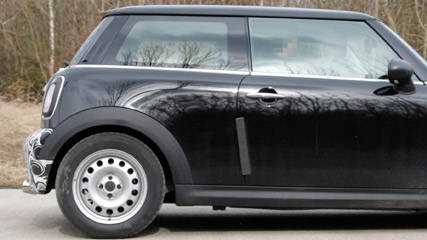
Mini Cooper S | spy shot
Read the article
By Paul Gover · 01 Apr 2010
So the 2011 Mini Cooper S facelift photographed by Carparazzi in Europe is essentially … more of the same.There are some small changes in terms of a revised air intake and it’s likely there could still be a surprise under that bumper camouflage. Some attention has also been paid to the light clusters, with the rear set now sporting LEDs.However, with the increasing pressure of emissions regulations, the Mini is also likely to have some upgraded engine technology aimed at reducing CO2 while improving outputs.Insiders are tipping that a variable-valve system will be added to the current 128kW/240Nm turbocharged 1.6-litre petrol engine, while the naturally aspirated 88kW/160Nm version will also be tweaked – although there are no hints of how much it will increase the outputs of either.

And the car Oscar goes to...
Read the article
By Mark Hinchliffe · 23 Mar 2010
Was it "Big Bopper" - the '79 XB Falcon from Mad Max, or Steve McQueen's '68 Mustang GT in Bullitt. Or could it be the '64 Aston Martin DB5 driven by Bond in Goldfinger. How about the Mini Coopers of 1969 in the Italian Job? Or, does the '77 Pontiac Trans Am from Smokey and The Bandit top your list?Take our poll below to tell us what you think, or leave a comment if your top pick is not listed.But if the Oscars gave out awards to cars instead of stars, Audi would probably get the most nominations. During the past few years, Audis have featured in all the Transporter movies, Ronin, I Robot, Mission Impossible 2, About a Boy, Legally Blonde 2, Hitman, The Matrix 2, Iron Man and now its sequel.In the first Iron Man, Robert Downey Jr plays Tony Stark (a.k.a 'Iron Man'). His workshop houses a 1932 Ford Flathead roadster, a 1967 Shelby Cobra, a Saleen S7, a prototype Tesla Roadster and a 2008 Audi R8.Supporting roles were played by the S5 sports sedan driven by American secret service agents and a Q7 SUV which is literally held up by Iron Man, who saves the family inside from the enemy. For the Australian premiere, Downey Jr arrived in a silver R8. In Iron Man 2 he drives an Audi R8 Spyder and his secretary, Pepper Potts (Gwyneth Paltrow), drives an A8 TDI.Audi Australia corporate communications general manager Anna Burgdorf could not confirm whether any payment was made for the placement. However, she could confirm that the super-sport R8 V10 Spyder will arrive here towards the end of the year.The R8 Spyder 5.2 FSI quattro features a lightweight-cloth top that opens automatically in about 19 seconds. Its V10 engine produces 386kW of power and launches the open-top two-seater to 100km/h in 4.1 seconds on its way to a top speed of 313km/h.Product placement of cars is not new to the sliver screen. Most critics believe it started with Bond films, notably the Aston Martin DB5 in Goldfinger, in 1964. Aston returned in 1965 for Thunderball and was replaced by the DBS for 1969's On Her Majesty's Secret Service.Other companies then got into the act of pushing their vehicles on to the Bond screen with the highlights being the amphibious Lotus Esprit in The Spy Who Loved Me and the launch of the BMW Z3 Roadster in GoldenEye. Even a pre-production Aston Martin DBS scored a role in Casino Royale, and scored a Guinness record for "the most cannon rolls in a car at the same time" - seven - for its very brief appearance.Iron Man 2 begins screening in Australia on April 29.
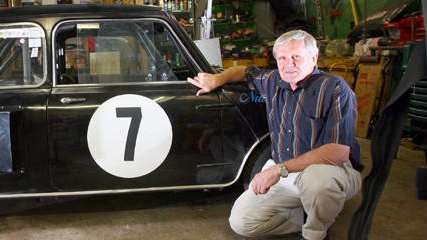
My 1964 Mini Cooper S
Read the article
By Mark Hinchliffe · 08 Mar 2010
Mini designer Alec Issigonis and performance tweaker John Cooper had a brain explosion in 1964 and developed a model with twin motors. Cooper crashed it, spent eight months in hospital and the idea was officially shelved. It hasn't stopped many backyard mechanics from having a go ever since, including Brisbane dentist Bill Westerman."Five years ago I was drinking beer with my friend Fred Sayers and we both decided to build one," he says in his garage littered with Mini engines in various states of rebuild. "Right from the word go — when the hangover cleared — we got stuck right into it."His 1964 Mini Cooper S with a "worn-out" 1293cc engine in the front and another in the back is called "Nuts". "Because you have to be nuts to drive it and it's better with two," says Westerman with a cheeky grin."I don't know what I paid for this one. It came from a shell. I had a shed load of Minis at the time. It's a sickness, you know."The graduate dentist began learning his mechanical skills from his first car which was a composite Series II Land Rover he made from two he bought at auction. His love of Minis started with his second purchase in 1969 when he bought a new Cooper S for $2500 and headed off to work in outback Waikerie, South Australia."I realised fairly quickly that what you really need in the outback is a V8, so I bought an XY Falcon ute," he says. "It went through a set of tyres every 6000 miles (9656km), a set of shocks every three months and universal joints at least once a year over those corrugated roads."His next car was a modified VB Commodore V8 wagon donated to the young dentist by Holden. He had it about five years before returning to Brisbane, more study at the University of Queensland and the start of his amateur career racing Minis from 1986 to today."The aim was to race all the circuits in Australia and I've just about done that except for Perth and Darwin," he says. "I've had a lot of fun. Racing has been very good to me. I've always been in the middle of the pack because I didn't spend enough money on the race car to win."His efforts to get more power out of a Mini and get further to the front of the pack led him down the ignominious Issigonis path of a twin-engined model. "We were worried after the first drive as it was an extremely difficult beast to keep on the road," he says. "There has to be co-ordination between the two motors. The gearing is the same and all the internals in the engine are the same, but we set the front so it was revving slightly harder so there is a bit of a pull factor."The revelation that kept the beast on the road came from an article in a 1960s Sportscar World magazine about the Formula One Ferguson all-wheel-drive race car. "We got a lot of hints from that; you need an overdrive diff on the front and back," he says. "We put one in the front and it made a bit of a difference and then we put one in the back and all of a sudden it goes. The diff takes up the front-to-back bias. It used to crab before that."The other major problem was the suspension. "Minis usually understeer, but this one was really taily at the start, not because of the weight in the rear but the front suspension we put in the rear. The problem was the back castor ... it had too much toe-in and we had to remove it. Instead of a steering box and steering geometry we made it into a straight-ahead suspension. Now I can drive it over all the ripple strips and still maintain control of the car. We have handling reasonable so now we are after more horsepower."Two more powerful engines in various stages of rebuild are sitting on the floor of his garage waiting to be thrown into the "Nuts" car. "I have the theoretical knowledge of mechanics to build an engine but Fred has the practical knowledge to make it work," he says. "It's been an interesting engineering exercise."Unfortunately, the car won't be ready in time for the second annual Cootha Classic hillclimb which Westerman organises for the Historic Racing Car Club of Queensland. "Maybe next year," he says.The Cootha Classic will be held on May 29-30 featuring more than 250 cars and about 50 motorcycles from the 1920s to today in timed sprints around a 1450m track up and down Sir Samuel Griffith Drive with seven corners and chicanes.Racing starts at 8.30am. Entry is $20 a day, $15 for concession, $30 for a two-day pass and $5 for parking in the J.C. Slaughter Falls carpark.Visit: www.visitbrisbane.com.au.
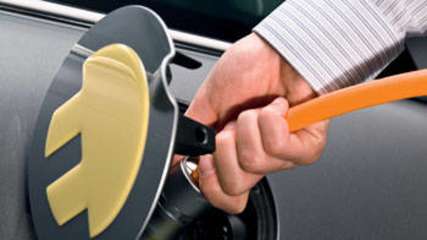
Mini set to plug in
Read the article
By Paul Gover · 22 Oct 2008
They are not toys. And the batteries are included.The Mini E is the first solid sign that the BMW Group is getting serious about electric motoring, promising a workable battery-powered range of more than 200 kilometres and running costs of less than five cents a kilometre.The funky plug-in is already up and testing in Europe ahead of a public unveiling at the Los Angeles Motor Show in the second week of November.A full fleet of 500 cars will be ready for action early next year, and will be sold into key US cities including LA and New York.The Mini E loses its conventional petrol or diesel engine in favour of a high-tech Lithium-Ion battery pack which powers a 150 kiloWatt electric motor.It is claimed to have a top speed of 150km/h, 0-100km/h time of 8.5 seconds and a re-charge time of less than three hours.The Mini move comes quickly after American officialdom demanded a percentage of each carmaker's fleet must be zero-emission by 2012, but not as quickly as Mercedes-Benz or Mitsubishi.Benz already has a 100-strong fleet of Smart electric cars under test in London and Mitsubishi plans to have its i-Miev electric minicar in full-scale production in 2009.The Mini E is being introduced as a test vehicle with government departments and a small number of private owners on a least system.There are no plans yet to bring the car to Australia, although Mercedes and Mitsubishi are both committed to local sales of their plug-ins and the i-Miev should be on the road locally in 2009.

Mini to go electric
Read the article
By Paul Gover · 03 Oct 2008
It's a plug-in electric car which will be previewed at the Los Angeles Motor Show ahead of sales of up to 500 cars in California through 2009.There was no sign of the Mini volt in Paris yesterday, even though Mercedes-Benz had its electric Smart on show and up and running, but the car is definitely coming."It's a plug-in. It looks like a Mini, drives like a Mini, but doesn't sound like a Mini," the global head of sales and marketing for BMW Group, Ian Robertson, says.He says BMW wants to get electric experience as soon as possible, not just in its cars but also to test the various infrastructure challenges from how and where to plug-in - at home, at work, at a government charging station - to the acceptance range for customers."We want to see how practical it is. We need to see if charging it at home works . . . right through to the issues of living with it."Robertson would not go into technical details on the electric Mini, not even the battery pack or range, but said everything would be obvious at LA in just over a month.
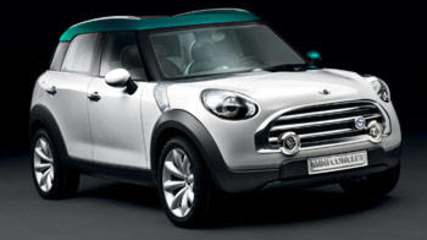
Offroad MINI concept
Read the article
By CarsGuide team · 19 Sep 2008
The car – which would be a fourth variant in MINI’s current model range — has four doors, four drive wheels, four single seats and measures four metres in the length.The body has two hinged doors on the passenger’s side (front and back), with a third for the driver. The fourth door, for the rear passenger on the driver’s side, slides back along the outside of the car.The rear door has a frameless, retractable window and when open, swivels to one side to help the loading of long items, such as skis, snowboards and surfboards.A folding cover that extends across the length of the roof increases luggage capacity, and there is an optional transport case that can be fitted on to the outside of the rear door.A matt aluminium fastening rail extending from the dashboard through the middle of the car to the rear can become a modular system with detachable cupholders and storage and entertainment units.
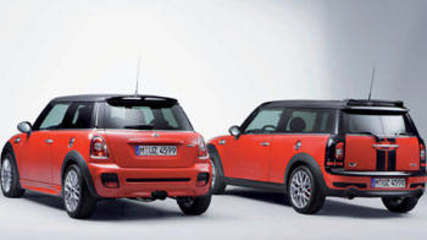
Mini Red hot
Read the article
By Stuart Innes · 25 Jul 2008
THE Mini brand makes no bones about it: its new cars will be `a pair of red-hot racers for the road'.Cashing in on the interest of the Mini Challenge race car series around Australia, the new John Cooper Works Mini and Clubman (station wagon) will run high-performance versions of the 1.6-litre engines used to power the familiar Cooper S along with other hot-up bits. Light alloy 17in diameter wheels, red caliper performance brakes and a new exhaust system are part of the go-faster kit on the John Cooper Works versions.“These cars will bring the thrill of the race track to the road,” says Mini national manager Justin Hocevar. “We are excited that these red-hot models will be coming to Australia at the same time as our Mini Challenge race series will be showcasing Mini handling and performance prowess at race tracks around Australia.”The engine has been uprated to generate 155kW of power at 6000rpm - not bad from a 1.6-litre motor. Torque is a good 260Nm on tap from 1850rpm to 5600rpm. But there's an over-boost system in the turbocharging, allowing a temporary 280Nm between 2000rpm and 5300rpm.The engines use aluminium cylinder blocks and bearing housings, twin camshafts and exhaust valves filled with sodium to better handle the cooling requirements.The John Cooper Works cars have reinforced and specially-ground pistons and special material for intake valves and valve seat rings to make them more resilient. The two-door and Clubman wagon have aero packages and sports chassis of springs finished in red, as well as rear spoilers and perforated brake discs.Mini says the cars are the first front-wheel drives to have the Dynamic Stability Control from parent company BMW.It allows the threshold at which these systems intervene to be raised, so allowing an amount of slip on the driving wheels. Stability control can be switched off, too.The standard Mini Cooper is no slug, especially if the road has some tighter twists and turns. It will accelerate to 100km/h in 9.1 seconds and run to 203km/h. The Cooper S does the sprint in 7.1 seconds on the way to 225km/h. The John Cooper version clocks 6.5 seconds and 238km/h or in the Clubman wagon 6.8 seconds and 238km/h. The Clubman weighs 75kg more than the two-door.The John Cooper Works versions get a six-speed manual gearbox (no auto option) that has been beefed up to take the high torque loads.They are performance cars but are still gentle on petrol use and emissions. The two-door Works car averages 6.9 litres/100km and the Clubman 7 litres/100km. Emissions are 165g/km and 167g/km.




